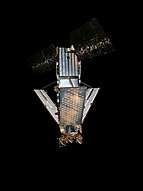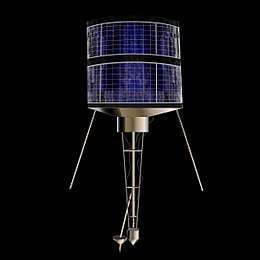2009 satellite collision
On February 10, 2009, two communications satellites—the active commercial Iridium 33 and the derelict Russian military Kosmos-2251—accidentally collided at a speed of 11,700 m/s (26,000 mph; 42,000 km/h) and an altitude of 789 kilometres (490 mi) above the Taymyr Peninsula in Siberia.[1][2][3] [4][5][6] It was the first time a hypervelocity collision occurred between two satellites – until then, all accidental hypervelocity collisions had involved a satellite and a piece of space debris.[7]
Spacecraft
Kosmos-2251 was a 950-kilogram (2,100 lb) Russian Strela military communications satellite owned by the Russian Space Forces.[8] It was launched on a Russian Cosmos-3M carrier rocket on June 16, 1993.[2] It had been deactivated prior to the collision, and remained in orbit as space debris. Iridium 33 was a 560-kilogram (1,200 lb) US-built commercial satellite and was part of the Iridium constellation of 66 communications satellites owned by Iridium Communications.[2] It was launched on September 14, 1997, atop a Russian Proton rocket.
Collision
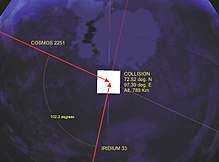
The collision occurred at 16:56 UTC and destroyed both the Iridium 33 and Kosmos-2251. The Iridium satellite was operational at the time of the collision. Kosmos-2251 had gone out of service in 1995.[9] It had no propulsion system,[10] and was no longer actively controlled.[11][12]
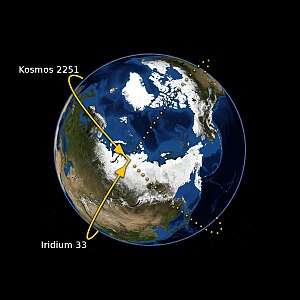 Point of collision
Point of collision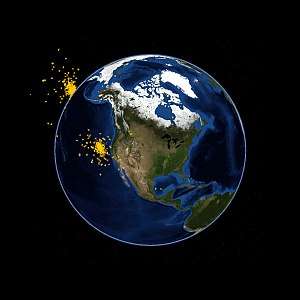 Debris fields after 20 minutes
Debris fields after 20 minutes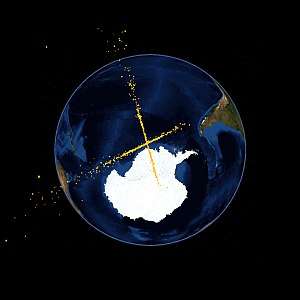 Debris fields after 50 minutes
Debris fields after 50 minutes
Fallout
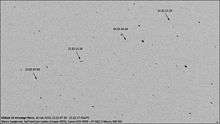
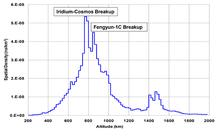
U.S. space agency NASA initially estimated ten days after the collision that the satellite space incident had created at least 1,000 pieces of debris larger than 10 cm (4 in), in addition to many smaller ones.[13] By July 2011, the U.S. Space Surveillance Network had catalogued over 2000 large debris fragments from the collision.[14] NASA determined the risk to the International Space Station, which orbits about 430 kilometres (270 mi) below the collision course, to be low,[8][15] as was any threat to the shuttle launch (STS-119) then planned for late February 2009.[8] However, Chinese scientists have said that the debris does pose a threat to Chinese satellites in Sun-synchronous orbits,[16] and the ISS did have to perform an avoidance maneuver due to collision debris in March 2011.[14]
By December 2011, many pieces of the debris were in an observable orbital decay towards Earth, and were expected to burn up in the atmosphere within one to two years. By January 2014, 24% of the known debris had actually decayed. In 2016, Space News listed the collision as the second biggest fragmentation event in history, with Kosmos-2251 and Iridium 33 producing respectively 1,668 and 628 pieces of catalogued debris, of which 1,141 and 364 pieces of tracked debris remain in orbit as of January 2016.[17]
A small piece of Cosmos 2251 satellite debris safely passed by the International Space Station at 2:38 am EDT, Saturday, March 24, 2012, at a distance of approximately 120 m (130 yd). As a precaution, ISS management had the six crew members on board the orbiting complex take refuge inside the two docked Soyuz rendezvous spacecraft until the debris had passed.[18]
A number of reports of phenomena in the US states of Texas, Kentucky, and New Mexico were attributed to debris from the collision in the days immediately following the first reports of the incident in 2009,[19] although NASA and the United States Strategic Command, which tracks satellites and orbital debris, did not announce any reentries of debris at the time[20] and reported that these phenomena were unrelated to the collision.[21] On February 13, 2009, witnesses in Kentucky heard sonic booms.[22] The National Weather Service issued an information statement alerting residents of sonic booms due to the falling satellite debris.[23] The Federal Aviation Administration also released a notice warning pilots of the re-entering debris.[24] Some reports include details that point to these phenomena being caused by a meteoroid shower.[20] A very bright meteor over Texas on February 15, 2009, was mistaken for reentering debris.[25]
Cause
Events where two satellites approach within several kilometers of each other occur numerous times each day. Sorting through the large number of potential collisions to identify those that are high risk presents a challenge. Precise, up-to-date information regarding current satellite positions is difficult to obtain. Calculations made by CelesTrak had expected these two satellites to miss by 584 meters (1,916 ft).[26]
Planning an avoidance maneuver with due consideration of the risk, the fuel consumption required for the maneuver, and its effects on the satellite's normal functioning can also be challenging. John Campbell of Iridium spoke at a June 2007 forum discussing these tradeoffs and the difficulty of handling all the notifications they were getting regarding close approaches, which numbered 400 per week (for approaches within five kilometers or three miles) for the entire Iridium constellation. He estimated the risk of collision per conjunction as one in 50 million.[27]
This collision and numerous near-misses have renewed calls for mandatory disposal of defunct satellites (typically by deorbiting them, or at minimum, sending them to a graveyard orbit), but no such international law exists as of 2020. Nevertheless, some countries have adopted such a law domestically, such as France in December 2010.[28] The United States Federal Communications Commission (FCC) requires all geostationary satellites launched after March 18, 2002, to commit to moving to a graveyard orbit at the end of their operational life.[29]
See also
- Kessler syndrome (ablation cascade) – a positive feedback loop where space debris creates more debris until all orbits are prohibited.
- Laser broom – a proposed method of getting rid of space debris
- Space Liability Convention
- ASM-135 ASAT - first known anti-satellite weapon test
- Operation Burnt Frost
- 2007 Chinese anti-satellite missile test – largest recorded space debris creation event
References
- McDowell, Jonathan (February 15, 2009). "Jonathan's Space Report No. 606". Archived from the original on April 5, 2017. Retrieved February 17, 2009.
Strela-2M satellites had lifetimes of around 3 years, and Gen. Yakushin of the Military Space Forces was quoted in Moscow Times as saying Kosmos-2251 went out of service in 1995.
- Iannotta, Becky (February 22, 2009). "U.S. Satellite Destroyed in Space Collision". Space.com. Archived from the original on February 13, 2009. Retrieved February 12, 2009.
- Achenbach, Joel (February 11, 2009). "Debris From Satellites' Collision Said to Pose Small Risk to Space Station". The Washington Post. Retrieved February 12, 2009.
- Marks, Paul (February 13, 2009). "Satellite collision 'more powerful than China's ASAT test". New Scientist. Archived from the original on February 15, 2009. Retrieved February 17, 2009. (putting the collision speed at 42,120 kilometres per hour (11.7 km/s))
- Matthews, Mark K. (February 13, 2009). "Crash imperils satellites that monitor Earth". Orlando Sentinel. Archived from the original on February 16, 2009. Retrieved February 17, 2009. (reporting it as "what amounted to a 26,000 mph [(7.7 miles/sec)] collision")
- "Collision between Iridium 33 and Cosmos 2251". N2YO. Archived from the original on February 16, 2009. Retrieved February 17, 2009.
- "Satellite Collision Leaves Significant Debris Clouds" (PDF). Orbital Debris Quarterly News. NASA Orbital Debris Program Office. 13 (2): 1–2. April 2009. Archived from the original (PDF) on May 27, 2010. Retrieved May 20, 2010.
- "Russian and US satellites collide". BBC. February 12, 2009. Archived from the original on February 12, 2009. Retrieved February 12, 2009.
- "First Satellite Collision Called Threat in Space". Moscow Times. February 13, 2009. Archived from the original on January 13, 2013. Retrieved February 19, 2009.
- Игорь Королев. Авария на $50 млн // Ведомости, № 26 (2296), 13 февраля 2009
- "Russian and US satellites collide". BBC News. February 12, 2009. Archived from the original on February 12, 2009. Retrieved February 12, 2009.
Russia has not commented on claims the satellite was out of control
- Wolf, Jim (February 11, 2009). "U.S., Russian satellites collide in space". Reuters. Archived from the original on February 15, 2009. Retrieved February 12, 2009.
- Oleksyn, Veronika (February 19, 2009). "What a mess! Experts ponder space junk problem". Associated Press. Retrieved May 20, 2010.
- "Orbital Debris Quarterly News, July 2011" (PDF). NASA Orbital Debris Program Office. Archived from the original (PDF) on October 20, 2011. Retrieved January 1, 2012.
- Dunn, Marcia (February 12, 2009). "Big satellites collide 500 miles over Siberia". The Associated Press. Archived from the original on July 11, 2011. Retrieved May 20, 2010.
- "China alert on U.S.-Russian satellite collision". Xinhua. February 12, 2009. Archived from the original on February 13, 2009. Retrieved February 12, 2009.
- "10 breakups account for 1/3 of catalogued debris". Space News. April 25, 2016. Retrieved June 27, 2017.
- Orbital Debris Safely Passes International Space Station (Web Broadcast). National Aeronautics and Space Association. March 23, 2012. Event occurs at 23 minutes 30 seconds. Retrieved March 23, 2012.
- Byrne, Joe (February 15, 2009). "Satellite wreckage falls on Kentucky, Texas, New Mexico". The Raw Story. Archived from the original on February 17, 2009. Retrieved February 16, 2009.
- Phillips, Tony (February 14, 2009). "Fireball Mania". National Aeronautics and Space Association. Retrieved December 14, 2011.
- Berger, Eric; Carreau, Mark (February 16, 2009). "Metallic meteorite likely sent fireball across Texas sky". Houston Chronicle. Retrieved February 16, 2009.
- "Satellites Collide; Debris Seen Falling Over Kentucky". WYMT News. February 13, 2009. Archived from the original on February 17, 2009. Retrieved February 16, 2009.
- "...POSSIBLE SATELLITE DEBRIS FALLING ACROSS THE REGION..." NOAA. February 13, 2009. Archived from the original on February 17, 2009. Retrieved February 16, 2009.
- Harwood, William (February 15, 2009). "FAA warns of possible falling satellite debris". CBS News Space Place. Archived from the original on February 19, 2009. Retrieved February 16, 2009.
- Plait, Phil (February 15, 2009). "Texas Fireball: What's known so far". Bad Astronomy blog. Retrieved February 17, 2009.
- "Iridium 33/Cosmos 2251 Collision". CelesTrak. Archived from the original on March 17, 2009. Retrieved March 18, 2009.
- Weeden, Brian (February 23, 2009). "Billiards in space". The Space Review. Archived from the original on February 26, 2009. Retrieved February 24, 2009.
- Reynolds, Glenn H (March 12, 2009). "Space Junk and the Law of Space Collisions". Popular Mechanics. Archived from the original on March 16, 2009. Retrieved March 18, 2009.
- Peter de Selding (June 28, 2004). "FCC Enters Orbital Debris Debate". Space News. Archived from the original on July 1, 2004.
External links
| Wikinews has news coverage of the 2009 satellite collision: |
- Courtland, Rachel (February 13, 2009). "Satellite crash prediction is plagued with uncertainty". New Scientist. Archived from the original on March 5, 2009. Retrieved February 13, 2009.
- Animations and graphic renderings of the collision
- Satellite collision animation video
- Satellite collision animation in 3D with Google Earth
